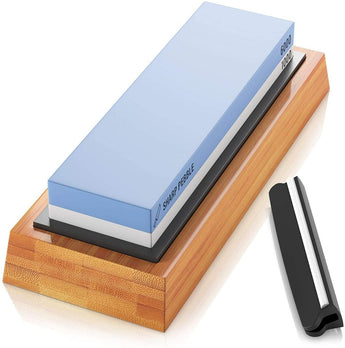
Knife sharpening stones, also known as whetstones, come in a variety of types, each designed for specific uses and maintenance techniques. One of the most notable distinctions is whether a stone is intended to be used with water or oil. This differentiation is not arbitrary; it stems from the materials used in the stones, their intended use, and the maintenance practices they require. Understanding why some sharpening stones are made for water and others for oil can help users select the right tool for their sharpening needs.
Composition of Sharpening Stones
Sharpening stones are made from various materials, which significantly influence whether they are designed for use with water or oil. Common materials include natural stones like novaculite (used in Arkansas stones) and man-made materials like aluminum oxide and silicon carbide.
-
Water Stones: Typically made from softer materials like aluminum oxide or a combination of abrasive materials bonded with clay or resins. These stones are designed to be soaked in water before use, which helps to create a slurry. This slurry is integral to the sharpening process, as it aids in removing metal from the blade and keeps the stone's surface from becoming clogged with metal particles.
-
Oil Stones: Often composed of harder materials such as novaculite (Arkansas stones), silicon carbide (Crystolon stones), or aluminum oxide (India stones). These stones require oil as a lubricant, which serves to float the metal particles away from the stone's surface and prevent clogging. The oil also provides a smoother sharpening action and can help protect the stone and blade from rust.
Functionality and Maintenance
The choice between water and oil as a lubricant affects not only the sharpening process but also the maintenance and longevity of the stone.
-
Water Stones: These stones are typically softer and can wear down more quickly, but they sharpen knives faster and more efficiently. The water used as a lubricant helps to cool the blade and the stone, reducing the risk of overheating. After use, water stones need to be dried thoroughly to prevent cracking. They may also require flattening more frequently, as their softer composition can lead to uneven surfaces over time.
-
Oil Stones: Generally harder and more durable, oil stones maintain their shape longer and require less frequent flattening. The oil used in these stones provides a smoother sharpening action and can prevent rust on both the stone and the blade. However, oil stones can be messier to use, and cleaning them after use involves more effort to remove the oil residue.
User Preference and Tradition
Historical and cultural factors also play a role in the preference for water or oil stones. In Japan, for example, water stones have been traditionally used for centuries, particularly for sharpening delicate and high-quality Japanese knives. These stones are favored for their ability to produce a sharp, polished edge quickly and efficiently.
In contrast, in the United States and Europe, oil stones have been more common historically, especially in woodworking and tool sharpening. The durability and lower maintenance needs of oil stones made them a practical choice for many users.
Practical Considerations
When choosing between water and oil stones, practical considerations come into play.
-
Availability: In some regions, one type of stone may be more readily available than the other, influencing the choice of users.
-
Ease of Use: Water stones are often favored by beginners because water is a more accessible and less messy lubricant compared to oil.
-
Purpose: The type of blade being sharpened can also dictate the choice. Water stones are ideal for fine edges and precision sharpening, making them perfect for kitchen knives and delicate tools. Oil stones, with their durability and smoother action, are better suited for tools that require a more robust edge, such as chisels and outdoor knives.



